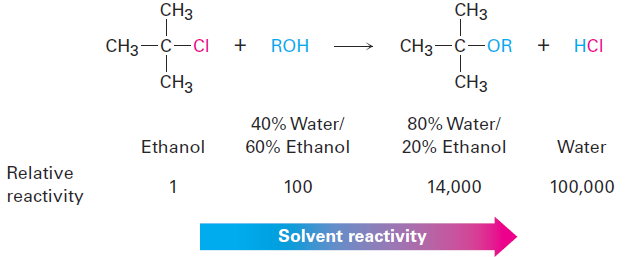
SN1 Reaction: The Solvent
 المؤلف:
John McMurry
المؤلف:
John McMurry
 المصدر:
Organic Chemistry
المصدر:
Organic Chemistry
 الجزء والصفحة:
9th. p 331
الجزء والصفحة:
9th. p 331
 31-5-2017
31-5-2017
 3541
3541
SN1 Reaction: The Solvent
What about the solvent? Do solvents have the same effect in SN1 reactions that they have in SN2 reactions? The answer is both yes and no. Yes, solvents have a large effect on SN1 reactions, but no, the reasons for the effects on SN1 and SN2 reactions are not the same. Solvent effects in the SN2 reaction are due largely to stabilization or destabilization of the nucleophile reactant, while solvent effects in the SN1 reaction are due largely to stabilization or destabilization of the transition state.
The Hammond postulate says that any factor stabilizing the intermediate carbocation should increase the rate of an SN1 reaction. Solvation of the carbocation—the interaction of the ion with solvent molecules—has such an effect. Solvent molecules orient around the carbocation so that the electronrich ends of the solvent dipoles face the positive charge (Fig ure 1.1), thereby lowering the energy of the ion and favoring its formation.

Figure 1.1 Solvation of a carbocation by water. The electron-rich oxygen atoms of solvent molecules orient around the positively charged carbocation and thereby stabilize it.
The properties of a solvent that contribute to its ability to stabilize ions by solvation are related to the solvent’s polarity. SN1 reactions take place much more rapidly in strongly polar solvents, such as water and methanol, than in less polar solvents, such as ether and chloroform. In the reaction of 2-chloro-2-methylpropane, for example, a rate increase of 100,000 is observed upon going from ethanol (less polar) to water (more polar). The rate increases when going from a hydrocarbon solvent to water are so large they can’t be measured accurately.

It should be emphasized again that both the SN1 and the SN2 reaction show solvent effects, but that they do so for different reasons. SN2 reactions are disfavored in protic solvents because the ground-state energy of the nucleophile is lowered by solvation. SN1 reactions are favored in protic solvents because the transition-state energy leading to carbocation intermediate is lowered by solvation.
 الاكثر قراءة في مواضيع عامة في الكيمياء العضوية
الاكثر قراءة في مواضيع عامة في الكيمياء العضوية
 اخر الاخبار
اخر الاخبار
اخبار العتبة العباسية المقدسة


